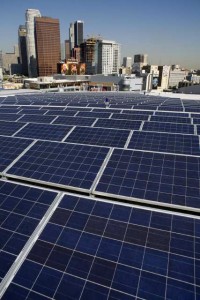 The Trump Administration’s new tariffs on foreign solar panels were met with cries of doom and gloom from some in the industry. But so far, the signs from the market may indicate that industry can weather the storm, albeit without the hoped-for gains in U.S jobs.
The Trump Administration’s new tariffs on foreign solar panels were met with cries of doom and gloom from some in the industry. But so far, the signs from the market may indicate that industry can weather the storm, albeit without the hoped-for gains in U.S jobs.
Two reasons stand out: first, the tariffs themselves are time-limited. As a result, foreign companies may be reluctant to make a long-term investment in moving their facilities to the U.S. for only a temporary gain, as E&E news reports [pay-walled]:
The tariffs, which begin at 30 percent in the first year and decline 5 percent each of the next three years, weren’t as extreme as the solar industry envisioned in terms of rate and length. That’s calmed fears for the broader domestic industry, though installations are still expected to fall.
But that also likely squashed the Trump administration’s goal of boosting domestic production — considered a long shot in any case by the broader solar industry — through a tariff and tariff-free quota for cell imports. That’s partly because companies might be willing to absorb the cost of tariffs in the short term rather than make more expensive, longer-term investments in the United States, which opponents of the tariffs argued was always the case.
Second, solar panel manufacturing appears at this point to be almost entirely automated, meaning few jobs are actually at stake. Take First Solar, a U.S. manufacturer that recently renovated its Ohio plant as an almost fully automated operation. As Bloomberg News reports:
Today a visitor to the factory, which reopened in December, looks out over a line of robotic arms guiding sheets of specialized conductive glass onto rollers that snake 3 miles through cleaning, grinding, and spraying machines. A final robot grabs the completed panel, about the size of a large flatscreen TV, and places it in a box for shipment. There are just a few dozen workers scattered about; before the renovation, there were hundreds. The company acknowledges that it’s cut jobs, but it says the ones that remain are safer and pay better.
As a result of the automated nature of solar manufacturing, it may be relatively cheap for those foreign companies who do wish to set up a plant in the U.S. to do so, albeit without any significant domestic job gains. For example, JinkoSolar just announced that it plans to invest more than $400 million in a manufacturing plant in Jacksonville, Florida by the end of 2019, apparently in response to the 30 percent tariffs, per the Wall Street Journal. If the company was planning to expand anyway and can save on shipping costs, this investment may be relatively minimal for them, compared to the alternative.
Meanwhile, to the extent that solar installers are hurt by this tariff, it seems clear that beneficiary will be natural gas. Bloomberg quoted SolarReserve Chief Executive Officer Kevin Smith along these lines:
“Solar energy’s main competition is natural gas and that’s where I think we’ll see some changes on the margins,” Smith said. “We’re going to see a shift to a little less solar and a little bit more gas sales.”
In the long term, increasing the price of solar by the 8-10% that some analysts predict from these tariffs only brings the price of solar PV back to where it was in 2016. And with further price declines due to industry innovation, plus the phasing out of these tariffs, the solar industry should weather this storm and emerge stronger after a few years. And in the meantime, the Trump Administration will likely have failed to slow the foreign advantage on solar panels or create the hoped-for domestic manufacturing job boost.


